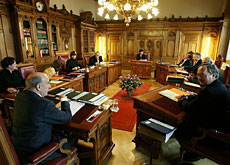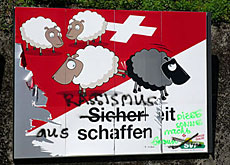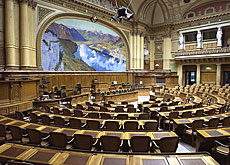Election campaign focuses on cabinet seats

Calls for changes to the make-up of the Swiss government are adding a new dimension to the campaign for the parliamentary elections in October.
The debates focus on the controversial justice minister, Christoph Blocher, and claims by the Green Party for a seat in the seven-member Swiss cabinet.
Blocher’s rightwing Swiss People’s Party launched a widely publicised campaign in the press about an alleged plot by other major political parties to throw its best-known politician out of the cabinet.
His frequent public appearances are marked by a strong police presence – which is quite unusual in the country – and have prompted demonstrations by anti-globalisation protesters and other critics of Blocher’s hardline stance, for example vis-à-vis foreigners.
Commentators and political experts have dismissed the latest campaigns by the People’s Party as attempts to dominate the political agenda.
The Green Party described the alleged plot revelations as “empty election propaganda”.
The Greens have called on other parties to vote Blocher out in December’s cabinet elections, according to secretary-general Hubert Zurkinden, in the hope of winning support beyond the centre-left in parliament.
High profile
Latest opinion polls show the People’s Party stagnating at about 26 per cent of the vote – making it the strongest group party in the House of Representatives ahead of the centre-left Social Democrats with about 23 per cent.
The two centre-right parties, the Radicals and the Christian Democrats currently stand at about 16 and 15 per cent respectively.
The People’s Party campaign stands out when it comes to catching the public eye and being successful.
“Forty-seven per cent of the respondents put the People’s Party campaign top,” the gfs.berne polling and research institute said. It added that none of the other parties manages to get as much attention outside its own ranks.
The isolationist party also made the headlines with controversial posters targeting foreigners, a key issue of the right-wingers.
Centre-left cabinet?
At the other end of the political spectrum the Green Party appears to be going from strength to strength.
They could increase the share of the vote to up to ten per cent in October according to pollsters.
The favourable outlook gives hope to party president Ruth Genner.
“I think we qualify for a seat. But it’s not quite clear yet when we will present a candidate,” said Genner.
She says the Greens will first have to win their first seat in the Senate, the chamber that represents Switzerland’s 26 cantons At the moment the group has 14 seats in the 200-seat House of Representatives.
Radicals
Claude Longchamp, head of the gfs.berne institute, says speculation about a possible Green cabinet member makes sense from a purely mathematical point of view.
“The question is: Can the Greens force a change in the cabinet-make up at the expense of the Radicals,” said Longchamp.
He acknowledges that such a scenario would indeed shift the power structure and give the centre-right Christian Democrat minister – at present Economics Minister Doris Leuthard – a key role between the right and the left.
But he points out that the chances of such an upset are very slim since the Greens are insisting on the expulsion of Blocher from the cabinet.
“In other words, the Greens are not really serious about their political foray,” said Longchamp.
Blocher for his part clearly counts on re-election and is pushing for a reshuffle of cabinet portfolios.
He is eyeing the interior ministry, currently led by Pascal Couchepin of the Radical Party.
swissinfo, Urs Geiser and Christian Raaflaub

More
Government, ministers, president
The seven-member cabinet – elected by parliament – is made of two representatives each of the People’s Party, the Social Democrats and the Radical Party.
The Christian Democrats lost one of their two seats in 2003 when Blocher clinched the second seat for his People’s Party.
Switzerland’s four main parties have been sharing seats in the cabinet for nearly 60 years.
Together they hold about 80 per cent of the seats in parliament.
The Green Party is the biggest opposition party with 14 seats in the House of Representaties, but none in the Senate.
Parliamentary elections take place every four years on the last Sunday in October.
Elections to the cabinet are scheduled for December.
So far all seven incumbent ministers are standing for re-election.

In compliance with the JTI standards
More: SWI swissinfo.ch certified by the Journalism Trust Initiative





You can find an overview of ongoing debates with our journalists here . Please join us!
If you want to start a conversation about a topic raised in this article or want to report factual errors, email us at english@swissinfo.ch.